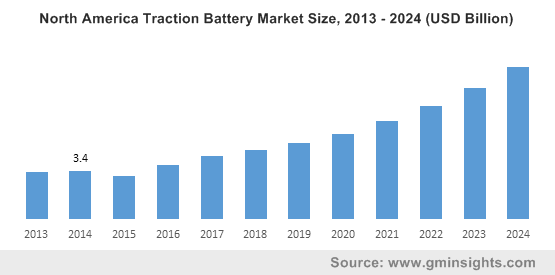Green revolution trends to drive traction battery market, APAC to register a double-digit CAGR of 11% over 2018-2024
Publisher : Fractovia | Published Date : 2018-09-21Request Sample
In the last few years, traction battery market has depicted a commendable growth with the increasing importance of emission-free and renewable energy sources. Owing to the adverse impact of fossil fuel based vehicular systems on the environment along with the growing carbon content in the atmosphere, many countries have taken to develop a strict regulatory framework. In addition, the depletion of fossil fuel sources has also encouraged many regional governments to become more dependent on renewables. The rising significance of energy efficiency has thus stimulated the use of EVs that have been significantly impelling traction battery industry trends.
North America Traction Battery Market Size, 2013 - 2024 (USD Billion)

In line with the stricter regulatory norms, many countries have already started to develop a sophisticated electric vehicle infrastructure. A majority of the nations have also been proactive in providing sufficient funding to the masses to enable the adoption of electric transportation facilities. Some of the countries like Germany have already invested in the development of alternative transportation facilities addressing the climate change and pollution. Recently, with the goal to implement a greener future, the German government inaugurated an electro-hybrid train that will help the country to reduce dependency on fossil fuel.
The increasing deployment of electric trains for energy efficiency, emissions, and noise free operations has had a positive influence on traction battery industry trends. Accordingly, prominent contenders have commenced the development of a new range of batteries endowed with higher capacities. Recently, ABB has launched a new traction technology for rail operators that leads to more energy savings, in turn, making rail transportation more sustainable. The Swiss train manufacturer, Stadler has also offered USD 100 million to ABB for improving rail operations and making them more energy efficient mainly across Europe and U.S. It is thus rather discernible that heavy investments in electric infrastructure development will generate lucrative opportunities for the players in traction battery market.
Speaking along the same lines, the well-known European automaker, Daimler has also signed a product supply contract with a Chinese company a couple of weeks earlier. Through this contract, the China-based Kaizhong Precision Technology will deliver structural components for Daimler’s traction battery packs. German carmakers have also set a target to terminate the sales of combustion engine vehicles by the end of 2030 – another factor that would turn out to be quite beneficial for the contributors in traction battery market.
In addition to Germany, other leading economies comprising France and UK have also decided to end the sales of conventional vehicles by 2040. The supportive regulatory initiatives set by the regional governments will thus boost Europe traction battery market size over the years ahead. Incidentally, Europe traction battery market size was pegged at USD 6 billion in 2017.
Regionally, China and India are also striving to develop an electric transportation infrastructure with the implementation of electric vehicle policies that will impel APAC traction battery market share. As per estimates, APAC traction battery market share is slated to register a CAGR of 11% over 2018-2024. The Chinese government is taking more aggressive steps to increase the sales of EVs – apparently, the government has commenced a consumer subsidy program that has resulted in an upsurge in the adoption of EVs. The increasing rate of electric vehicle development and the subsequent growth in its sales are poised to propel traction battery market across China.
With the gradually developing e-vehicle infrastructure across the globe, giants in traction battery market have been focusing on the development of next-generation batteries that will help them gain competitive benefits. Tesla is one of those companies which is continuously investing in research and development activities to invent new ranges of batteries for future. As of now, with its Japanese counterpart, Panasonic Corp, Tesla is looking forward to developing cost-effective and eco-friendly batteries with the surging demand for electric cars across the globe.
In the future, the increasing deployment of EVs and railroad transportation across the globe will certainly generate considerable demand for traction battery aftermarket. In accordance, tech giants are looking forward to establishing advanced battery infrastructure that will help them combat the rising demand and emerge as industry leaders. Powered by the shifting focus of regulatory bodies toward eco-friendly rail-road transportation, traction battery market size is anticipated to be pegged at an appreciable USD 65 billion by the end of 2024.